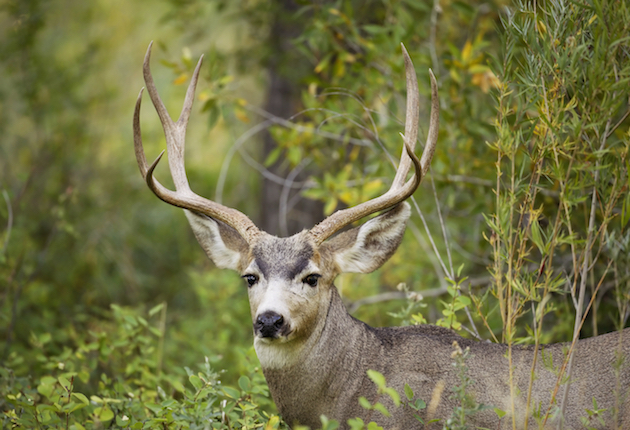In the old days it was the regular thing with most ranchmen to take a trip in the fall for the purpose of laying in the winter’s supply of venison. I frequently took such trips myself, and though occasionally we killed wapiti, bighorn, prongbuck, and whitetail, our ordinary game was the mule deer. Around my ranch it was not necessary to go very far. A day’s journey with the wagon would usually take us to where a week’s hunting would enable us to return with a dozen deer or over. If there was need of more, I would repeat the hunt later on.
I have several times killed three of these deer in a day, but I do not now recall ever killing a greater number. It is perhaps unnecessary to say that every scrap of flesh was used.
These hunts were always made late in the fall, usually after the close of the rut. The deer were then banded and were commonly found in parties of from three or four to a score, although the big bucks might be lying by themselves. The weather was apt to be cold, and the deer evidently liked to sun themselves, so that at midday they could be found lying, sometimes in thin brush and sometimes boldly out on the face of a cliff or hill. If they were unmolested, they would feed at intervals throughout the day, and not until the bands had been decimated by excessive hunting did they ever spend the hours of daylight in hiding.
On such a hunt, our proceedings were perfectly simple. The nights were longer than the days, and therefore we were away from camp at the first streak of dawn, and might not return until long after darkness. All the time between was spent in climbing and walking through the rugged hills, keeping a sharp lookout for our game. Only too often we were seen before we ourselves saw the quarry, and even when this was not the case, the stalks were sometimes failures.
Still, blank days were not very common. Probably every hunter remembers with pride some particular stalk. I recall now outwitting a big buck which I had seen and failed to get on two successive days. He was hanging about a knot of hills with brush on their shoulders, and was not only very watchful, but when he lay down always made his bed at the lower end of a brush patch, whence he could see into the valley below, while it was impossible to approach him from above, through the brush, without giving the alarm.
On the third day I saw him early in the morning while he was feeding. He was very watchful, and I made no attempt to get near him, simply peeping at him until he finally went into a patch of thin brush and lay down.
As I knew what he was, I could distinctly make him out. If I had not seen him go in, I certainly never would have imagined that he was a deer, even had my eyes been able to pick him out at all among the gray shadows and small, dead treetops.
Having waited until he was well settled down, I made a very long turn and came up behind him, only to find that the direction of the wind and the slope of the hill rendered it an absolute impossibility to approach him unperceived. After careful study of the ground, I abandoned the effort and returned to my former position, having spent several hours of considerable labor in vain. It was now about noon, and I thought I would lie still to see what he would do when he got up, and accordingly I ate my lunch stretched at full length in the long grass which sheltered me from the wind.
From time to time I peered cautiously between two stones toward where the buck lay. It was nearly mid-afternoon before he moved. Sometimes mule deer rise with a single motion, all four legs unbending like springs, so that the four hoofs touch the ground at once. This old buck, however, got up very slowly, looked about for certainly five minutes, and then came directly down the hill and toward me.
When he had nearly reached the bottom of the valley between us, he turned to the right and sauntered rapidly down it. I slipped back and trotted as fast as I could without losing my breath along the hither side of the spur which lay between me and the buck.
While I was out of sight, he had for some reason made up his mind to hurry, and when I was still 50 yards from the end of the spur he came in sight just beyond it, passing at a swinging trot. I dropped on one knee so quickly that, for a moment, he evidently could not tell what I was—my buckskin shirt and gray slouch-hat fading into the color of the background—and halted, looking sharply around.
Before he could break into flight, my bullet went through his shoulders.
Note: An excerpt from “The Mule Deer, or Rocky Mountain Blacktail,” a chapter from The Deer Family, by Roosevelt, T.S. Van Dyke, and D.G. Elliot, published in 1903. For more great books from Theodore Roosevelt and others, visit the Sporting Classics Store today.

